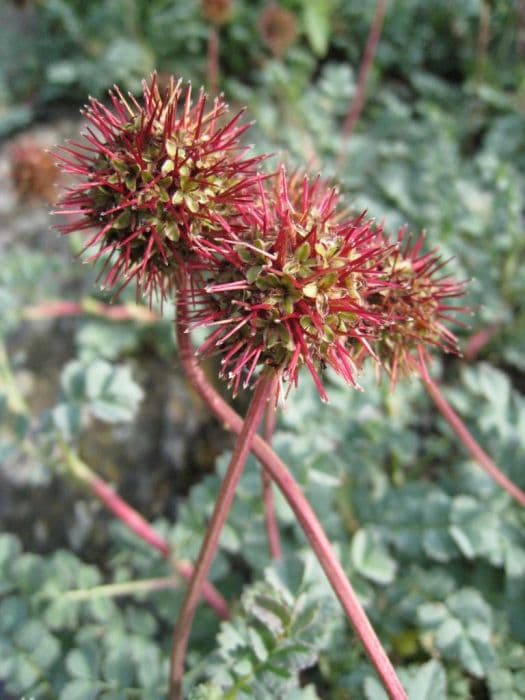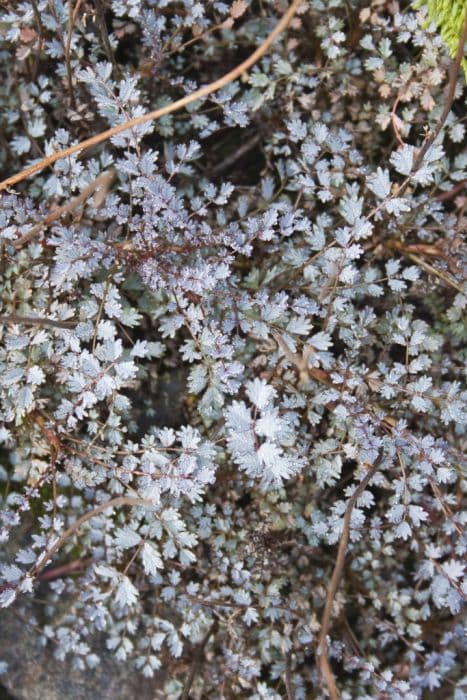Raspberry Rubus idaeus 'Leo' (PBR) (F)

ABOUT
Rubus idaeus 'Leo' is a cultivated variety of the red raspberry, a plant known for its delicious fruit. This particular variety is characterized by its sturdy canes which are slightly thorny, providing support for the plant. The leaves are a bright green color with a slightly fuzzy texture, and they are pinnately compound, meaning they are divided into smaller leaflets that line up on either side of the central stem. Come spring, the raspberry 'Leo' plant produces a profusion of small, white flowers. These blooms have five petals and are attractive to bees and other pollinators. Following the blooming period, the fertilized flowers give way to the fruit for which the plant is most commonly known. The raspberries themselves are the highlight of this plant. They are typically a deep red color though can be lighter, depending on ripeness, with an aggregated structure made up of many small individual drupelets. Each berry is juicy and plump, enclosing a small seed within. The fruit is popular for its sweet and slightly tart flavor, and it is often used in making desserts, jams, or eaten fresh as a delightful snack.
About this plant
 Names
NamesFamily
Rosaceae
Synonyms
Leo Raspberry
Common names
Rubus idaeus 'Leo'.
 Toxicity
ToxicityTo humans
The plant known commonly as raspberry is not considered toxic to humans. In fact, raspberries, including Rubus idaeus 'Leo', are edible and nutritious fruits commonly consumed around the world. There are no well-documented cases of poisoning from eating raspberries or their plant parts in humans, and they are safe for human consumption when ripe. However, it is always recommended to eat only the ripe fruit and avoid ingesting leaves or stems in large quantities, as they may contain small amounts of substances that could be irritating or cause mild stomach upset, although such cases are rare.
To pets
Raspberry plants, including the Rubus idaeus 'Leo' variety, are considered non-toxic to most pets including dogs and cats. The fruit is generally safe for pets to consume in moderation. However, the leaves and stems may cause mild gastrointestinal upset if ingested in large quantities. There should be no severe toxicity or serious consequences from pets ingesting parts of raspberry plants. It is always best to supervise pets and prevent them from eating large amounts of any plant material to avoid potential stomach upset.
 Characteristics
CharacteristicsLife cycle
Perennials
Foliage type
Deciduous
Color of leaves
Green
Flower color
White
Height
5 feet (1.52 meters)
Spread
3 feet (0.91 meters)
Plant type
Shrub
Hardiness zones
4
Native area
Europe
Benefits
 General Benefits
General Benefits- Edible Fruits - The raspberry plant produces delicious, edible berries that are often used in various culinary dishes and desserts.
- Attracts Pollinators - Raspberries attract bees and other pollinators, which are essential for the health of the ecosystem.
- Aesthetic Appeal - With its lush green foliage and bright berries, the raspberry adds beauty to gardens and landscapes.
- Provides Habitat - The dense growth habit of raspberry bushes offers shelter for small wildlife and beneficial insects.
- Easy to Grow - Raspberry plants are robust and can thrive in a variety of soil types, making them accessible to many gardeners.
- Self-fertile - Many raspberry varieties, including the 'Leo', do not require cross-pollination, so gardeners can get a good crop from a single plant.
- Perennial Growth - Raspberry plants are perennial, meaning they come back year after year, providing long-term garden interest.
- Can Be Grown in Containers - For those with limited space, raspberries can be grown in containers, making them suitable for patios and balconies.
 Medical Properties
Medical Properties- Anti-inflammatory: Raspberry leaves may reduce inflammation and help with conditions associated with inflammation.
- Antioxidant: Raspberries are high in antioxidants, which can help protect the body from oxidative stress and may have anti-aging benefits.
- Astringent: The tannins in raspberry leaves can have astringent properties, which might help tighten tissues and reduce secretions.
- Gastrointestinal aid: Raspberry leaf tea is traditionally used to help with digestive upset and diarrhoea.
- Menstrual relief: Raspberry leaf is commonly used to help ease menstrual discomfort and may support uterine health.
 Air-purifying Qualities
Air-purifying QualitiesThis plant is not specifically known for air purifying qualities.
 Other Uses
Other Uses- Raspberry 'Leo' can be used to create natural dyes for fabric and art projects, providing hues ranging from soft pinks to deep reds.
- The plant's leaves, when dried, can be incorporated into handmade paper, adding texture and a hint of fragrance.
- Raspberry 'Leo' canes are strong and pliable, making them suitable for crafting small woven items such as baskets or decorative pieces.
- The thorns of the raspberry plant can be used as natural needles or awls in traditional crafting techniques.
- Raspberry 'Leo' foliage can be used as mulch in the garden to help retain moisture and suppress weeds.
- The fruit of Raspberry 'Leo', aside from human consumption, can be used to feed birds and attract wildlife to your garden.
- Raspberry plants can serve as a natural barrier or hedging due to their thorny canes and dense growth habit.
- Raspberry 'Leo' can be used in educational gardens to teach pruning techniques, as it requires regular maintenance for optimal fruit production.
- The plant's root system is beneficial for erosion control, helping to stabilize soil in sloped areas of the garden.
- Raspberry leaves can be used to add flavor to smoked meats and cheeses when used in a smoker.
Interesting Facts
 Feng Shui
Feng ShuiThe raspberry plant is not used in Feng Shui practice.
 Zodiac Sign Compitability
Zodiac Sign CompitabilityThe raspberry plant is not used in astrology practice.
 Plant Symbolism
Plant Symbolism- Protection: Raspberry plants are known for their thorns, which serve to protect the plant from herbivores, symbolizing the idea of safeguarding and shelter.
- Fertility and Abundance: Raspberry bushes produce an abundance of fruit, often associated with fertility, plentifulness, and the nurturing aspect of nature.
- Sweetness and Pleasure: The sweet taste of raspberries is often linked to the pleasures of life, indulgence, and the enjoyment of the fruits of one's labor.
- Kindness: Rasberry's association with the Virgin Mary in certain cultures represents kindness, motherly love, and compassion.
- Youth: The bright and fresh appearance of the raspberry fruit can symbolize youthfulness and vitality.
 Water
WaterRaspberry 'Leo' should be watered with about 1-2 inches of water per week, depending on weather conditions and soil moisture levels. It's important to keep the soil around raspberries consistently moist but not waterlogged. Water the plants deeply once or twice a week rather than a little every day to encourage deep root growth. During hot or dry periods, you may need to water more frequently. Always check the soil before watering; if the top inch is dry, it's time to water.
 Light
LightRaspberry 'Leo' thrives best in full sunlight, which means they should receive at least 6 to 8 hours of direct sunlight each day. Planting them in a spot that has clear access to sunlight throughout the day without significant shade is ideal for healthy growth and fruit production. Full sun encourages strong stems and maximizes fruit yield.
 Temperature
TemperatureRaspberry 'Leo' plants can generally withstand winter cold and can survive in temperatures down to about -20°F once established. They grow best at temperatures between 70-75°F during the growing season. Avoid planting in sites where temperatures frequently exceed 85°F, as excessive heat can stress the plants and affect fruit production.
 Pruning
PruningPruning Raspberry 'Leo' is necessary to improve fruit production and plant health. Remove all weak, damaged, or dead canes each spring and thin the remaining canes to about 6 inches apart. After fruiting, prune out the canes that have produced fruit as they will not fruit again. The best time for pruning is late winter or early spring before new growth starts.
 Cleaning
CleaningAs needed
 Soil
SoilRaspberry 'Leo' thrives in well-drained, fertile soil with a pH of 5.5 to 6.5. A mix of garden soil, compost, and sand or peat moss can create optimal conditions for growth.
 Repotting
RepottingRaspberries, like 'Leo', do not typically require repotting as they are often planted directly in the ground. Instead, they spread by runners and need periodic thinning.
 Humidity & Misting
Humidity & MistingRaspberry 'Leo' prefers moderate humidity but is adaptable to a range of conditions. It does not require high humidity levels for optimal growth.
 Suitable locations
Suitable locationsIndoor
Ensure full sun, well-draining soil, and ample space for canes.
Outdoor
Plant in sun, fertile soil, and provide support for canes.
Hardiness zone
4-8 USDA
 Life cycle
Life cycleRubus idaeus 'Leo', commonly known as 'Leo' Raspberry, starts its life cycle as a seed which germinates in spring under appropriate temperature and soil conditions. The seedling develops into a cane, or primocane, which grows vegetatively during the first year, establishing a root system and producing a number of leafy stems. These primocanes become floricanes in their second year, during which they flower and produce fruit, typically in early to mid-summer. After fruiting, the floricanes usually die back, while new primocanes emerge to ensure continuation for the next cycle. The raspberry plant continues this biennial bearing cycle, with primocanes maturing into fruit-bearing floricanes every year. As a perennial, the plant can live and be productive for several years with proper care and management.
 Propogation
PropogationPropogation time
Summer
Propogation: The Rubus idaeus 'Leo', commonly known as the Leo raspberry, is often propagated by taking root cuttings. The ideal time for this method is in early spring, just before new growth begins, or in the fall after the plant has gone dormant. For root cuttings, small pieces of roots, typically 4 to 6 inches (about 10 to 15 centimeters) in length, are cut from a mature raspberry plant. These root segments are then planted horizontally in a moist, soil-based mixture, about 2 to 3 inches (5 to 7.5 centimeters) deep. It's important to maintain consistent moisture levels without overwatering, as this can lead to rot. Within several weeks in the right conditions, the root cuttings will begin to sprout new shoots, eventually growing into new raspberry plants that will possess the characteristics of the parent 'Leo' variety.









